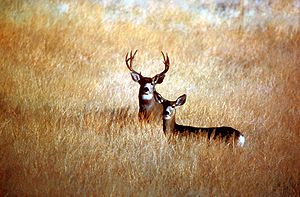As winter approaches in South Dakota, the Department of Game, Fish and Parks (GFP) reminds resident hunters of a unique opportunity that may exist later this
winter.
The GFP has a Wildlife Damage Management Program that assists landowners with various wildlife depredation abatement techniques. However, when other methods are ineffective, GFP may utilize willing hunters to help reduce damage caused by wildlife.
“Winter depredation hunts are a valuable management tool that GFP uses in some situations to alleviate wildlife damage to landowners’ stored-feed supplies,” said Wildlife Damage Program Administrator Keith Fisk. “Depredation hunts are largely dependent upon the severity of the winter, snowfall accumulations and the number of animals involved. During mild winters, few hunts are conducted; however, when extreme conditions cause wildlife to congregate near farmsteads and livestock feeds, depredation hunts are more common.”
South Dakota residents may register for potential depredation hunts for deer, antelope and turkey starting Dec. 1, 2013. Hunters can register for depredation hunts (free of charge) at http://gfp.sd.gov/hunting/
“New for 2013, hunters may register for a maximum of 10 counties,” said Fisk. “Depredation hunts are often time-sensitive and winter weather can sometimes make travel difficult for participating hunters. For a successful hunt, GFP needs participating hunters to be available at the hunt location almost immediately.”
Once registered, hunters are then put into a random drawing to determine eligibility once a depredation hunt is authorized.
Winter depredation hunts focus on assisting landowners with wildlife damage, but also can provide hunters with another hunting opportunity after tradition hunting seasons are closed. For more information, please visit the GFP website or contact GFP at (605)223-7660.



















